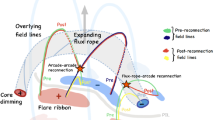Abstract
In order to understand whether major flares or coronal mass ejections (CMEs) can be related to changes in the longitudinal photospheric magnetic field, we study 4 young active regions during seven days of their disk passage. This time period precludes any biases which may be introduced in studies that look at the field evolution during the short-term flare or CME period only. Data from the Michelson Doppler Imager (MDI) with a time cadence of 96 min are used. Corrections are made to the data to account for area foreshortening and angle between line of sight and field direction, and also the underestimation of the flux densities. We make a systematic study of the evolution of the longitudinal magnetic field, and analyze flare and CME occurrence in the magnetic evolution. We find that the majority of CMEs and flares occur during or after new flux emergence. The flux in all four active regions is observed to have deviations from polarity balance both on the long term (solar rotation) and on the short term (few hours). The long-term imbalance is not due to linkage outside the active region; it is primarily related to the east–west distance from central meridian, with the sign of polarity closer to the limb dominating. The sequence of short-term imbalances are not closely linked to CMEs and flares and no permanent imbalance remains after them. We propose that both kinds of imbalance are due to the presence of a horizontal field component (parallel to the photospheric surface) in the emerging flux.
Similar content being viewed by others
References
Amari, T., Luciani, J. F., Aly, J. J., and Tagger, M.: 1996, Astron. Astrophys. 306, 913.
Ambastha, A., Hagyard, M. J., and West, E. A.: 1993, Solar Phys. 148, 277.
Antiochos, S. K., Devore, C. R., and Klimchuk, J. A.: 1999, Astrophys. J. 510, 485.
Aulanier, G. and Démoulin, P.: 1998, Astron. Astrophys. 329, 1125.
Berger, T. and Lites, B. W.: 2003, Solar Phys., 213, 213.
Bommier, V., Landi Degl'Innocenti, E., Leroy J.-L., and Sahal-Bréchot, S.: 1994, Solar Phys. 154, 231.
Bumba, V. and Howard R.: 1965, Astrophys. J. 141, 1492.
Brueckner, G. E., Howard, R. A., Koomen, M. J. et al.: 1995, Solar Phys. 162, 357.
Chen, J., Wang, H., Zirin, H., and Ai, G.: 1994, Solar Phys. 154, 261.
Choudhary, D. P., Venkatakrishnan, P., and Gosain, S.: 2002, Astrophys. J. 573, 851.
Delaboudinière, J.-P., Artzner, G. E., Brunaud, J. et al.: 1995, Solar Phys. 162, 291.
Delannée, C., Delaboudiniére, J.-P., and Lamy, P.: 2000, Astron. Astrophys. 355, 725.
Démoulin, P., Mandrini, C. H., van Driel-Gesztelyi, L. et al.: 2002, Astron. Astrophys. 382, 650.
Dryer, M., Andrews, M. D., Aurass, H. et al.: 1998, Solar Phys. 181, 159.
Feynman, J. and Martin, S. F.: 1995, J. Geophys. Res. 100, 3355.
Gaizauskas, V., Mandrini, C. H., Démoulin, P., Luoni, M. L., and Rovira, M. G.: 1998, Astron. Astrophys. 332, 353.
Gary, G. A. and Démoulin, P.: 1995, Astrophys. J. 445, 982.
Giggerich, O., Noyes, R. W., Kalkofen, W., and Cuny, Y.: 1971, Solar Phys. 18, 347.
Green, L.M., Matthews, S. A., van Driel-Gesztelyi, L., Harra, L. K., and Culhane, L. J.: 2002a, Solar Phys. 205, 325.
Green, L. M., López Fuentes, M. C., Mandrini, C. H., Démoulin, P., van Driel-Gesztelyi, L., and Culhane, J. L.: 2002b, Solar Phys. 208, 43.
Hagyard, M. J., Stark, B. A., and Venkatakrishnan, P.: 1999, Solar Phys. 184, 133.
Hagyard, M. J., Smith, J. B. Jr., Teuber, D., and West, E. A.: 1984, Solar Phys. 91, 115.
Harvey, K. L. and Harvey, J. W.: 1976, Solar Phys. 47, 233.
Howard, R. F.: 1991, Solar Phys. 134, 233.
Isenberg, P. A., Forbes, T. G., and Démoulin, P.: 1993, Astrophys. J. 417, 368.
Klimchuk, J. A., Canfield, R. C., and Rhoads, J. E.: 1992, Astrophys. J. 385, 327.
Lara, A., Gopalswamy, N., and DeForest, C.: 2000, J. Geophys. Res. 27, 1435.
Li, H., Sakurai, T., Ichimoto, K., and Ueno, S.: 2000a, Publ. Astron. Soc. Japan 52, 465.
Li, H., Sakurai, T., Ichimoto, K., and Ueno, S.: 2000b, Publ. Astron. Soc. Japan 52, 483.
Lin, J., Forbes, T. G., and Isenberg, P. A.: 2001, J. Geophys. Res. 106, 25053.
Lin, H., Penn, M. J., and Tomczyk, S.: 2000, Astrophys. J. 541, L83.
Liu, Y. and Norton, A.: 2001, MDI Measurement Errors: The Magnetic Perspective, MDI Technical Note, TN-01-144, http://soi.stanford.edu/general/tech_notes.html.
Mandrini, C.H., van Driel-Gesztelyi, L., Thompson, B. J. et al.: 2000, Geof. Inter. 39, 73.
Martres, M.-J., Michard, R., Soru-Iscovici, I., and Tsap, T. T.: 1968, Solar Phys. 5, 187.
Pevtsov, A. A.: 2000, Astrophys. J. 531, 553.
Plunkett, S., Brueckner, G. E., Dere, K. P. et al.: 1997, Solar Phys. 175, 699.
Pope, T. and Mosher, J.: 1975, Solar Phys. 44, 3.
Sakurai, T., Shibata, K., Ichimoto, K., Tsuneta, S., and Acton, L. W.: 1992, Publ. Astron. Soc. Japan 44, L123.
Scherrer, P. H., Bogart, R. S., Bush, R. I. et al.: 1995, Solar Phys. 162, 129.
Tang, Y. H., Mouradian, Z., Schmieder, B., Fang, C., and Sakurai, T.: 1999, Solar Phys. 185, 143.
Thompson, B. J., Plunkett, S. P., Gurman, J. B. et al.: 1998, Geophys. Res. Lett. 25, 14, 2461.
van Driel-Gesztelyi, L., Mandrini, C. H., Thompson B. et al.: 1999, in B. Schmieder, A. Hofmann, J. Staude. (eds.), Third Advances in Solar Physics Euroconference: Magnetic Fields and Oscillations, ASP Conference Series 184, 302.
Wang, H., Ewell, M. W. Jr., Zirin, H., and Ai, G.: 1994, Astrophys. J. 424, 436.
Wang, H., Spirock, T. J., Jiong, Q. et al.: 2002, Astrophys. J. 576, 497.
Wang, Y.-M. and Sheeley, N. R., Jr.: 1999, Astrophys. J. 510, 157.
Author information
Authors and Affiliations
Rights and permissions
About this article
Cite this article
Green, L., Démoulin, P., Mandrini, C. et al. How are Emerging Flux, Flares and CMEs Related to Magnetic Polarity Imbalance in Midi Data?. Solar Physics 215, 307–325 (2003). https://doi.org/10.1023/A:1025678917086
Issue Date:
DOI: https://doi.org/10.1023/A:1025678917086




